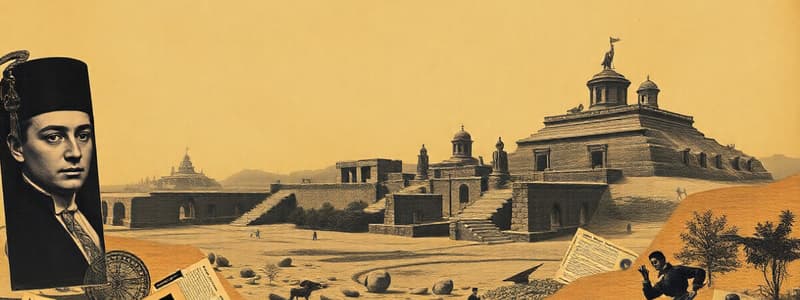Podcast
Questions and Answers
What is the main theme explored in Shelley's 'Ozymandias'?
What is the main theme explored in Shelley's 'Ozymandias'?
- The beauty of nature
- The permanence of legacy
- The impermanence of empire (correct)
- The triumph of love
What is the structure of 'Ozymandias'?
What is the structure of 'Ozymandias'?
- A ballad
- A haiku
- A sonnet (correct)
- A free verse poem
Who is the subject of the poem 'Ozymandias'?
Who is the subject of the poem 'Ozymandias'?
- Ramses II (correct)
- Cleopatra
- Tutankhamun
- Nefertiti
With whom did Percy Shelley compete to write 'Ozymandias'?
With whom did Percy Shelley compete to write 'Ozymandias'?
In what year was 'Ozymandias' published?
In what year was 'Ozymandias' published?
What is the significance of the phrase 'Look on my Works, ye Mighty, and despair!'?
What is the significance of the phrase 'Look on my Works, ye Mighty, and despair!'?
What do the 'vast and trunkless legs of stone' symbolize in the poem?
What do the 'vast and trunkless legs of stone' symbolize in the poem?
Which of the following best describes the tone of 'Ozymandias'?
Which of the following best describes the tone of 'Ozymandias'?
What is the primary theme of 'Ozymandias' as illustrated in the poem?
What is the primary theme of 'Ozymandias' as illustrated in the poem?
How does Shelley emphasize the power of nature in 'Ozymandias'?
How does Shelley emphasize the power of nature in 'Ozymandias'?
What artistic technique does Shelley employ in 'Ozymandias' to unify the poem?
What artistic technique does Shelley employ in 'Ozymandias' to unify the poem?
What do the 'trunkless legs' of the statue symbolize in the poem?
What do the 'trunkless legs' of the statue symbolize in the poem?
How does Shelley contrast art and imperial power in 'Ozymandias'?
How does Shelley contrast art and imperial power in 'Ozymandias'?
What significance does the inscription on the statue's pedestal carry?
What significance does the inscription on the statue's pedestal carry?
What literary form does 'Ozymandias' utilize, and how does it affect its meaning?
What literary form does 'Ozymandias' utilize, and how does it affect its meaning?
Flashcards
Ozymandias's identity
Ozymandias's identity
Ozymandias was a name for a powerful ancient Egyptian king, Ramses II.
Ozymandias's statue
Ozymandias's statue
A statue of Ozymandias, once grand, now lies broken in the desert, a symbol of past power's decay.
Shelley's poem style
Shelley's poem style
Shelley's 'Ozymandias' is a fourteen-line sonnet, a traditional poetic form.
Poem's central theme
Poem's central theme
Signup and view all the flashcards
'Ozymandias' publication date
'Ozymandias' publication date
Signup and view all the flashcards
Ozymandias's inscription
Ozymandias's inscription
Signup and view all the flashcards
Shelley vs. Smith
Shelley vs. Smith
Signup and view all the flashcards
Archaeological discoveries
Archaeological discoveries
Signup and view all the flashcards
Ozymandias's Empire Decline
Ozymandias's Empire Decline
Signup and view all the flashcards
Power of Nature
Power of Nature
Signup and view all the flashcards
Timelessness of Art
Timelessness of Art
Signup and view all the flashcards
Sonnet Form
Sonnet Form
Signup and view all the flashcards
Enjambment
Enjambment
Signup and view all the flashcards
Imperial Decline
Imperial Decline
Signup and view all the flashcards
Study Notes
"Ozymandias" by Shelley: Study Notes
- Poet and Poem: Poem by Romantic poet Percy Bysshe Shelley, published in 1818. A sonnet (14 lines).
- Ozymandias' Identity: Ozymandias is a Greek name for Ramses II, an ancient Egyptian king. The poem focuses on the statue of Ozymandias (a common motif during Ramses' reign).
- Historical Context: European archaeologists were unearthing Egyptian artifacts, including statues, during Shelley's time. This likely influenced the poem.
- Poetic Competition: Shelley wrote "Ozymandias" partly as a competition with his friend Horace Smith. Both created sonnets with the same title.
- Poem Summary: The poem describes a traveler encountering a ruined statue of Ozymandias in the desert. The statue's face is damaged, and the inscription on the pedestal proclaims Ozymandias's power ("Look on my Works, ye Mighty, and despair!"). However, the surrounding city is in ruins; only the statue remains.
- Themes:
- Impermanence of empires: The poem highlights how even powerful empires eventually decline and fall. Ozymandias’ grandeur is contrasted with his ruins.
- Power of nature: The desert's vastness and unrelenting nature symbolize forces beyond human control. The sands overwhelm Ozymandias's creation.
- Timelessness of art: Art (like poetry) potentially outlives empires. Shelley's poem survives long after the empire.
- Form and Structure:
- Sonnet Form: The poem adheres to the sonnet's structure of 14 lines and iambic pentameter.
- Rhyme Scheme: ABABA CDC EDE FEF.
- Enjambment: The lines flow into each other, creating a sense of continuity and unity.
- Symbolism:
- Ruined Statue: Represents the fading glory of empires and the transience of power.
- Desert and Sands: Represent the relentless passage of time and the indifference of nature to human creations.
- Inscription: Ozymandias's arrogance and his misjudgement of permanence.
- Comparison to Horace Smith's Poem: Both poems share similar subjects but vary in their style and focus.
Studying That Suits You
Use AI to generate personalized quizzes and flashcards to suit your learning preferences.




